Identify the plant which has compound leaves:
- Banana
- Banyan
- Mango
- Rose
Answer
Rose
Reason — Rose leaf is a compound leaf with incisions upto midrib.
Which one of the following is not an insectivorous plant:
- Pitcher plant
- Venus flytrap
- Bladderwort
- Cactus
Answer
Cactus
Reason — Cactus has modified leaves into spines due to which it does not trap insects.
This leaf shows parallel venation
- Banana
- Mango
- Banyan
- Guava
Answer
Banana
Reason — In Banana leaves, veins runs parallel to each other.
The point on the stem from where the leaf arises is :
- Petiole
- Lamina
- Node
- Trunk
Answer
Node
Reason — The points on the stem from where the leaves and branches originate are called nodes.
Which one of the following is essential for photosynthesis :
- Carbon dioxide
- Nitrogen
- Oxygen
- Soil
Answer
Carbon Dioxide
Reason — Out of the given options, Carbon dioxide is needed for photosynthesis.
Which part of the leaf attaches the leaf base to the stem ?
- Leaf blade
- Lamina
- Leaf apex
- Petiole
Answer
Petiole
Reason — The basal part of a leaf is a stalk called petiole, which is attached to the stem at the node.
The bud found at the tip of the shoot is termed as :
- Axillary bud
- Apical bud
- Adventitious bud
- Floral bud
Answer
Apical bud
Reason — The tip of the shoot has buds called apical buds or terminal buds. They are responsible for the vertical growth of the stem.
The divided, smaller parts of the lamina of a compound leaf are called as :
- Leaf spines
- Stipules
- Leaflets
- Tendrils
Answer
Leaflets
Reason — In a compound leaf, the leaf blade or lamina is divided into smaller units called leaflets.
Which of the following is not an example of a compound leaf ?
- Rose
- Silk cotton
- Neem
- Prickly poppy
Answer
Prickly poppy
Reason — Prickly poppy has simple leaves as its lamina is undivided and is a single piece.
The plant which has whorled phyllotaxy is :
- Nerium
- Jasmine
- Mint
- Peepal
Answer
Nerium
Reason — Nerium has whorled phyllotaxy as it has more than two leaves attached at each node, arranged in a whorl.
Match the terms given in column A with those of column B.
| Column A | Column B |
|---|---|
| (i) Root system | (a) Photosynthesis |
| (ii) Stem | (b) New branches |
| (iii) Leaves | (c) Vegetative propagation |
| (iv) Axillary bud | (d) Node and internode |
| (v) Bryophyllum | (e) Fixation of the plant |
Answer
| Column A | Column B |
|---|---|
| (i) Root system | (e) Fixation of the plant |
| (ii) Stem | (d) Node and internode |
| (iii) Leaves | (a) Photosynthesis |
| (iv) Axillary bud | (b) New branches |
| (v) Bryophyllum | (c) Vegetative propagation |
Name the following:
- The part of the plant which grows under the ground.
- The part of the plant which grows above the soil.
- The wide flat portion of the leaf.
Answer
- Root
- Shoot
- Lamina / Leaf Blade
What are the four functions of roots?
Answer
The main four functions of the roots are as follows:
- It helps to anchor the plant firmly to the soil.
- It absorbs water and minerals from the soil for the growth of the entire plant.
- It transports the absorbed water and minerals to the shoot system.
- It binds the soil together so that it does not get washed away during rain or blown away by wind.
Mention the functions of the following:
- Spines
- Tendril
- Scale leaves
Answer
- Spines — Spines are modifications of leaves as a pointed structure that help to reduce the loss of water by transpiration.
- Tendril — Incase of certain weak-stemmed plants, leaves or leaflets are modified into wiry, coiled structures called tendrils. They coil around the object they touch and support the plant to climb up.
- Scale Leaves — Leaves modified as thick and fleshy or thin and dry are called Scale Leaves. Their function is to store food and protect the buds.
Define venation. What are the different types of venation found in the leaves?
Answer
Arrangement of veins in the lamina is called venation. It is mainly of two types
- Reticulate Venation — In this type of venation, veins and veinlets are irregularly distributed in the lamina, forming a network. Example - Mango, Peepal, etc.
- Parallel Venation — In this type of venation, veins run parallel to each other. Example - Banana, Maize, etc.
Describe the modifications of leaf in any one insectivorous plant?
Answer
In Venus Flytrap, the leaves have long pointed hairs. It is divided into two parts having midrib in between like a hinge. When an insect visits the leaf, it closes its two parts and traps the insect. The insect is then digested by digestive juices secreted by the plant.
Write the two main functions of leaves?
Answer
Two main functions of the leaves are:
- Photosynthesis.
- Transpiration.
Define:
- Photosynthesis
- Transpiration
Answer
Photosynthesis — Photosynthesis is the process by which a plant leaf prepares own food from water and carbon dioxide in the presence of chlorophyll and sunlight.
Transpiration — Transpiration is the process by which water is lost in the form of water vapour by evaporation from the surface of leaves and other aerial parts of a plant.
Name the following :
- Two organ systems of the plant
- Two main types of the root system
- Five parts of the shoot system
- Three types of phyllotaxy
- Two types of venation
Answer
- The Root system and the Shoot system.
- The Tap root system and the Fibrous root system.
- Stem, Buds, Leaves, Flowers, and Fruits.
- Alternate, Opposite, and Whorled.
- Reticulate venation and Parallel venation.
Define the terms given below :
- Phyllotaxy
- Leaf
- Autotrophic nutrition
- Leaf tendril
- Vegetative propagation
Answer
Phyllotaxy — The arrangement of leaves on a stem or its branch is called phyllotaxy. Phyllotaxy are of three types- Alternate, Opposite, and Whorled.
Leaf — Leaves are the flat and green parts of the shoot that grow laterally from the nodes of the stem. They perform important functions like photosynthesis and transpiration.
Autotrophic nutrition — All green plants have the capability to prepare their own food, and are therefore called autotrophs, and this method of nutrition is called autotrophic nutrition.
Leaf tendril — In case of certain weak-stemmed plants, leaves or leaflets are modified into wiry, coiled structures called tendrils. They are sensitive to touch. As they touch any object, they coil around it and support the plant to climb up.
Vegetative propagation — Sometimes new plants may also be produced from other (vegetative) parts of the plant such as the roots, stems and leaves instead of seeds. This type of reproduction is called vegetative propagation.
Give a term for the following.
- The fine hair-like projections from the ends of the root branches.
- The part of the stem between two successive nodes.
- The kind of leaves without a petiole.
- The technical term of a leaf stalk.
- The pigment which traps solar energy for the process of photosynthesis.
Answer
- Root hairs
- Internode
- Sessile leaves
- Petiole
- Chlorophyll
Giving examples, differentiate between Tap root and Fibrous root
Answer
Differences between Tap Root and Fibrous Root:
| Tap root | Fibrous root |
|---|---|
| There is one large, thick main root. | There is a cluster of root of the same thickness. |
| Penetrates deeply into the soil. | Does not penetrate deeply, is shallow. |
| Tap roots are found in dicot plants. | Fibrous roots are found in monocot plants. |
| Example — Gram, Pea. | Example — Maize, Grass. |
Giving examples, differentiate between Simple leaf and Compound Leaf
Answer
Differences between Simple leaf and Compound leaf:
| Simple leaf | Compound leaf |
|---|---|
| Lamina is undivided and is a single piece. | Lamina is divided into smaller units called leaflets. |
| Marginal incisions, if present, do not reach upto the midrib or petiole. | Incisions reach upto the midrib or petiole. |
| Example — Mango, Banana, Banyan, etc. | Example — Rose, Neem, Clover, etc. |
Giving examples, differentiate between Parallel venation and Reticulate Venation
Answer
Differences between Parallel venation and Reticulate venation:
| Parallel venation | Reticulate venation |
|---|---|
| Veins run parallel to each other. | Veins and veinlets are irregularly distributed in the lamina forming a network. |
| Parallel venation is found in monocot plants. | Reticulate venation is found in dicot plants. |
| Example — Banana, Maize. | Example — Peepal, Mango. |
What is the modification seen in Bryophyllum? Explain.
Answer
Modification seen in bryophyllum are:
- Bryophyllum is a plant whose leaves produce adventitious buds in their margin.
- The adventitious buds grow into new plants when they fall off from the parent plant.
What purpose is served by the spines borne on the leaves of cactus ?
Answer
Cactus being a desert plant needs to conserve water. So, its leaves are modified into pointed structures called as spines to reduce the loss of water by transpiration.
Explain why leaf survival is so important to the plant ?
Answer
Leaf survival is so important to plants because:
- The leaf makes food for the plants by photosynthesis.
- The leaf gets rid of excess water from plants through transpiration.
- The leaf carries out the process of respiration in plants.
- The leaf helps in providing cooling effect to the plant through transpiration.
Give an example of the following and draw generalized diagrams for the same:
(i) Simple leaf and compound leaf.
(ii) Parallel venation and reticulate venation.
Answer
(i) Banyan is an example of simple leaf while Rose is an example of compound leaf.
Below diagram shows simple and compound leaves:

(ii) Banana is an example of parallel venation while Peepal is an example of reticulate venation.
Below diagram shows reticulate and parallel venation:

Enlist some of the advantages of transpiration to green plants?
Answer
The two main advantages of transpiration to green plants are as follow:
- Cooling effect — The water keeps on evaporating from the leaf surface during transpiration. The heat required for evaporation of water is obtained from the plant itself and thus, the plant cools itself when it is in hot environment.
- Transpirational pull — The roots of the plant pull up more water from the soil to make up for the water loss during transpiration. As a result, important mineral salts, which is essential for the plant growth, are also brought along with the water from the soil.
Why do some plants have to trap insects?
Answer
Insectivorous plants trap insects because they grow in soil which is usually thin and is also low in nutrients, so insectivorous plants eat insects to fullfil their nitrogen demand.
Explain some of the modifications of leaves found in plants?
Answer
Modifications of leaves are as follows:
- Leaf tendril — In case of certain weak-stemmed plants, leaves or leaflets are modified into wiry, coiled structures called tendrils. They coil around the object they touch and support the plant to climb up. E.g., Sweet Pea.
- Leaf spines — In some plants, leaves are modified into pointed structures called spines. Spines help to reduce water loss by transpiration. E.g., Cactus.
- Scale leaves — In some plants like Onion and Ginger, thick and fleshy or thin and dry scale leaves are present, respectively. Their function is to store food and protect the buds.
What is a tendril? Explain its use to the plants?
Answer
In case of certain weak-stemmed plants, leaves or leaflets are modified into wiry, coiled structures called tendrils. They are sensitive to touch. As they touch any object, they coil around it and support the plant to climb up. E.g., Sweet pea.
Distinguish between the following pairs on the basis of the words indicated in the brackets []:
Spines and scale leaves [significance]
Answer
Difference between Spines and scale leaves on the basis of significance:
| Spines | Scale leaves |
|---|---|
| Spine leaves are modified into spines to reduce water loss. | Scale leaves help to store food and protect the buds. |
Distinguish between the following pairs on the basis of the words indicated in the brackets []:
Vegetative and reproductive parts [parts of the plant].
Answer
Difference between Vegetative and reproductive parts on the basis of parts of the plant:
| Vegetative parts | Reproductive parts |
|---|---|
| These are non reproductive part which are involved in growth and development of the plant eg. roots, stems, leaves | These parts are involved in reproduction of plants eg. flower, seeds, fruits etc. |
Distinguish between the following pairs on the basis of the words indicated in the brackets []:
Alternate and opposite phyllotaxy [number of leaves at each node].
Answer
Difference between Alternate and opposite phyllotaxy on the basis of number of leaves at each node :
| Alternate phyllotaxy | Opposite phyllotaxy |
|---|---|
| In Alternate phyllotaxy, there is only one leaf per node and the leaves are positioned in an alternate manner along the stem. | In Opposite arrangement, there are two leaves per node, positioned directly in a opposite fashion to each other. |
Distinguish between the following pairs on the basis of the words indicated in the brackets []:
Pine and peepal [shape of the leaf].
Answer
Difference between Pine and peepal on the basis of shape of the leaf:
| Pine | Peepal |
|---|---|
| Pine leaves are long, thin, needle, scale-like, and pointed. | Peepal leaves are heart shaped and broad. It generally has a long and pointed tip. |
Distinguish between the following pairs on the basis of the words indicated in the brackets []:
Reticulate and parallel venation [2 examples of each].
Answer
Difference between Reticulate and parallel venation on the basis of 2 examples:
| Reticulate venation | Parallel venation |
|---|---|
| Mango and Guava leaves are examples of Reticulate venation. | Banana and Maize leaves are examples of Parallel venation. |
Draw a neat diagram of a simple, petiolate leaf showing reticulate venation and label its seven important parts. Answer the following questions:
(i) Write one important function of axillary buds.
(ii) What are the two main function of leaves ?
(iii) Name two plants which have leaves with serrated margins.
(iv) Why do some plants have tendrils (modified leaflets) ?
(v) Name a plant in which the leaves are modified into spines.
Answer
Diagram:
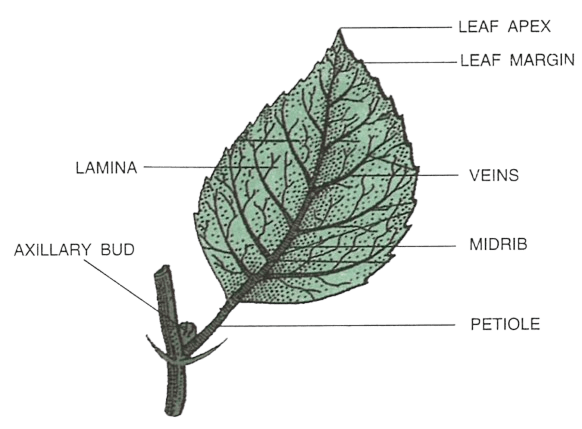
(i) One important function of axillary buds is to develop into lateral shoots or branches, contributing to the plant's overall growth and structure.
(ii) The two main functions of leaves are:
- Photosynthesis — The process by which a plant leaf prepares or synthesises food from water and carbon dioxide in the presence of chlorophyll and sunlight is called photosynthesis.
- Transpiration — This is the process by which water is lost in the form of water vapour by evaporation from the surface of leaves and other aerial parts of a plant. It has a cooling effect and develops a suction force to make roots absorb more water with mineral ions.
(iii) China rose and Rose.
(iv) In case of certain weak-stemmed plants, leaves or leaflets are modified into wiry, coiled structures called tendrils. They are sensitive to touch. As they touch any object, they coil around it and support the plant to climb up.
(v) Cactus
The figures given below show three insectivorous plants. Study the same and answer the following questions :
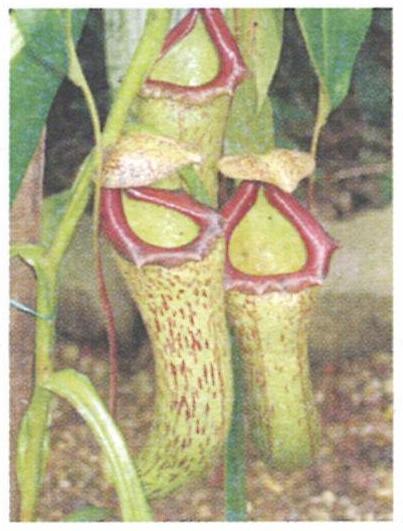
A
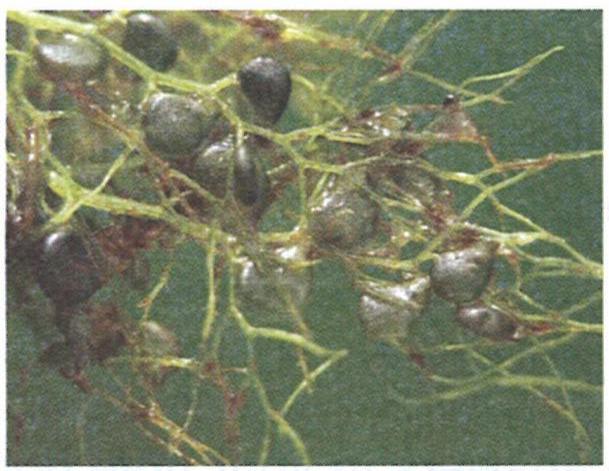
B
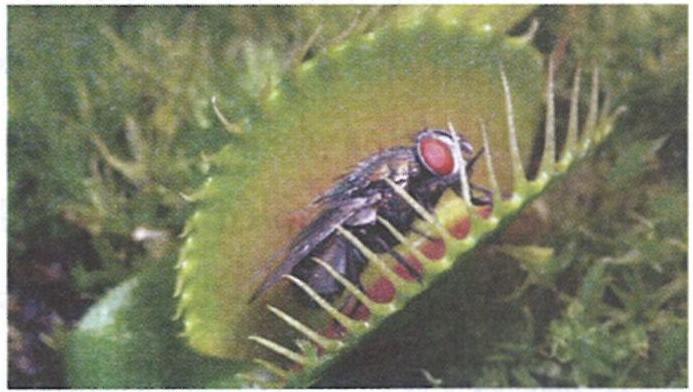
C
(i) Name the plants shown as A, B and C.
(ii) For which specific nutritional element do these plants trap insects ?
(iii) In which Indian state is plant A found abundantly ?
(iv) Which part of the leaf is modified into a pitcher in plant A ?
(v) Write one specific feature of the soil in which these plants usually grow.
Answer
(i)
Plant A — Pitcher Plant
Plant B — Bladderwort
Plant C — Venus Flytrap
(ii) These plants trap insects to meet their nitrogen demands.
(iii) Pitcher plant is found abundantly in Meghalaya.
(iv) In a Pitcher plant, the lamina is modified into a pitcher.
(v) The soil where these plants usually grow is deficient in nitrates.
The figures given alongside represent the different kinds of leaf arrangements on the stem. Study the figures and answer the following :
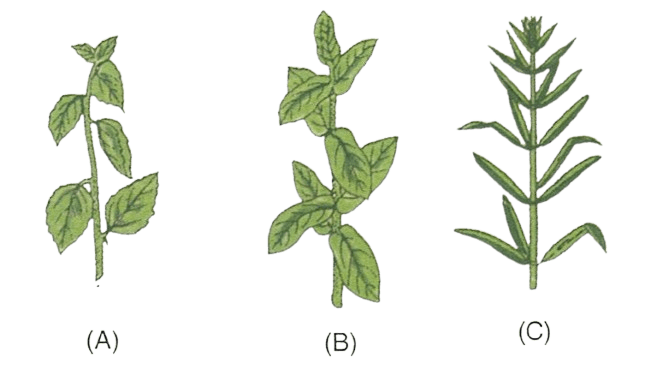
(i) a technical term for the arrangement of leaves on the stem.
(ii) Name the three kinds of arrangements shown in the figure A, B and C respectively.
(iii) Give one example of each kind of arrangement.
Answer
(i) Phyllotaxy.
(ii)
Figure A shows Alternate phyllotaxy.
Figure B shows Opposite phyllotaxy.
Figure C shows Whorled phyllotaxy.
(iii)
An example of Alternate phyllotaxy — Mint
An example of Opposite phyllotaxy — Jasmine
An example of Whorled phyllotaxy — Oleander (Nerium)
Draw neat diagrams of the following and give an example of each :
(i) A simple leaf.
(ii) A compound leaf with incision upto midrib.
(iii) A compound leaf with incision upto petiole.
(iv) A simple leaf with reticulate venation.
(v) A simple leaf with parallel venation.
Answer
(i) Diagram of simple leaf:
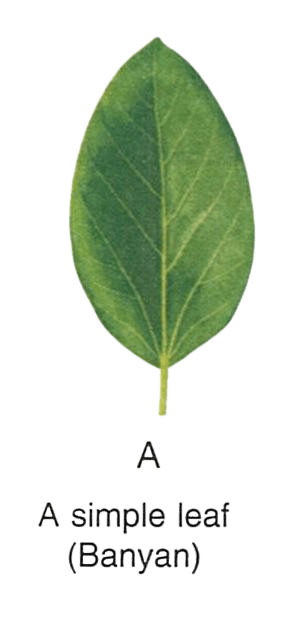
Example — Banyan
(ii) Diagram of compound leaf with incision upto midrib:
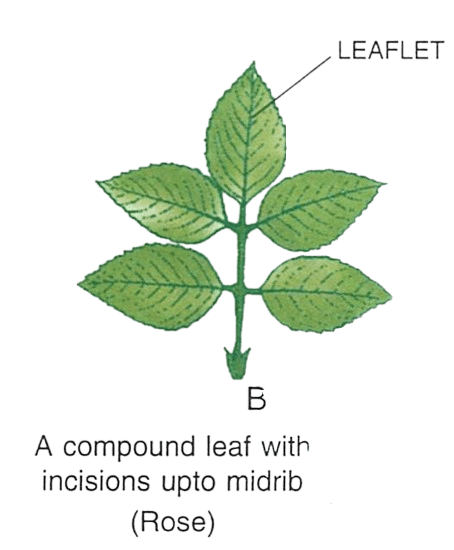
Example — Rose
(iii) Diagram of compound leaf with incision upto petiole:
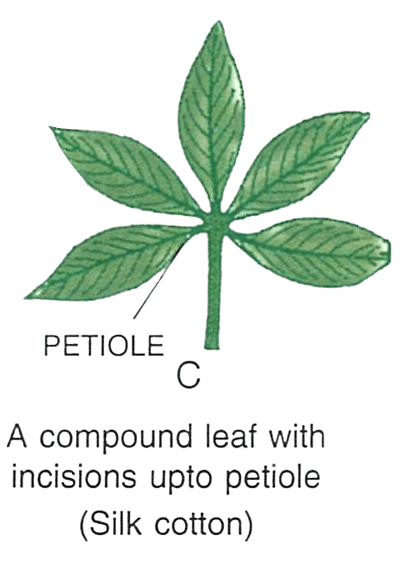
Example — Silk Cotton
(iv) Diagram of a simple leaf with reticulate venation:
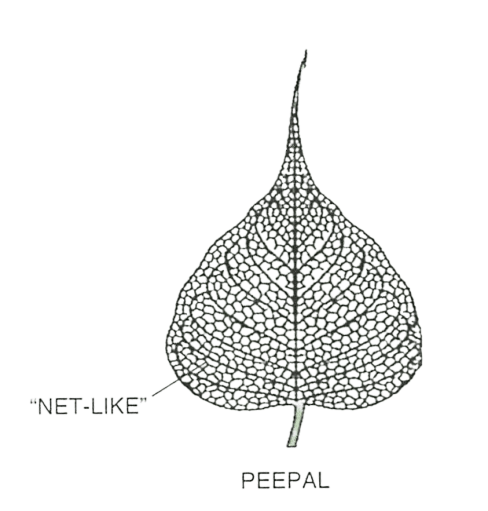
Example — Peepal
(v) Diagram of a simple leaf with parallel venation
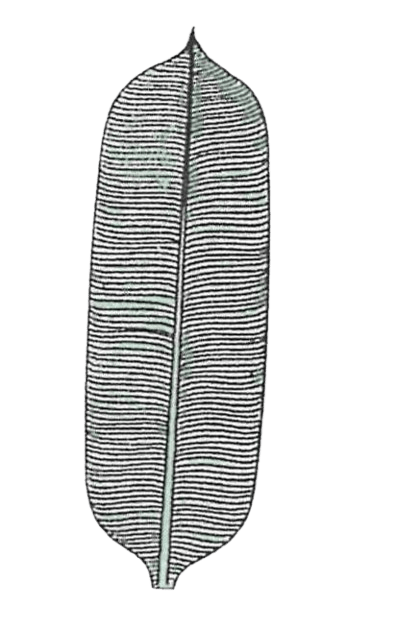
Example — Banana
Complete the crossword using the clues given below. Check your performance with the correct solutions given at the end of the chapter.

Clues across :
- Plant that bears buds in leaves for propagation.
- The flattened green part of leaf.
- Underground plant part.
- Structure that develops into flower.
Clues down :
- The central big vein of a leaf.
- A modification seen in cactus.
Answer

Across :
1. Bryophyllum
2. Lamina
3. Root
4. Bud
Down :
5. Midrib
6. Spine